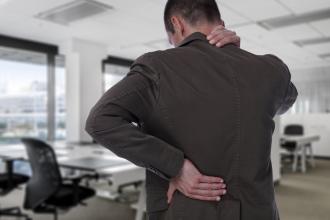Clinical practice guideline for low back pain
Low back pain (LBP) is a common symptom presenting in both primary care and across many specialties. LBP has bio-psychosocial components. The psychosocial aspects are significant determinants of disability and deserve our attention from the start. The 2007 clinical practice guideline for LBP summarizes the evidence as to what is important, what works, what we know, and what we don’t know.
According to Dr Roger Chou, lead author of the guideline and a speaker at the WorkSafeBC 2011 Annual Physician Education Conference, coming to Vancouver on 22 October, the guideline is “firmly grounded in the evidence, developed from a true multidisciplinary perspective and resonates clinically…. The guideline has been widely disseminated—downloaded more than 250000 times from the Annals of Internal Medicine website and is the second most downloaded article ever published in the Annals… Although the guideline was published in 2007, no new evidence would appear to require changes to the recommendations, and subsequent studies on LBP imaging and chronicity-predicting factors are consistent with the guideline recommendations.”
Recommendations
While the complete guideline can be viewed at www.annals.org/content/147/7/478.full, here’s a summary of the recommendations:
• Conduct a focused history and physical exam to help place patients with LBP into one of three categories: nonspecific LPB, back pain potentially associated with radiculopathy or spinal stenosis, or back pain potentially associated with another specific spinal cause. The history should include assessment of psychosocial risk factors that predict risk for chronic disabling back pain (strong recommendation, moderate-quality evidence).
• Do not routinely obtain imaging or other diagnostic tests in patients with nonspecific LBP (strong recommendation, moderate-quality evidence).
• Perform diagnostic imaging and testing for patients with LBP when severe or progressive neurologic deficits are present or when serious underlying conditions are suspected on the basis of history and physical examination (strong recommendation, moderate-quality evidence).
• Evaluate patients using MRI (preferred) or CT only when they have persistent LBP and signs or symptoms of radiculopathy or spinal stenosis, and are potential candidates for surgery or epidural steroid injection (for suspected radiculopathy) (strong recommendation, moderate-quality evidence).
• Provide patients with evidence-based information on LBP about their expected course, advise patients to remain active, and provide information about effective self-care options (strong recommendation, moderate-quality evidence).
• Consider using medications with proven benefits in conjunction with back care information and self-care; assess severity of baseline pain and functional deficits, potential benefits, risks, and relative lack of long-term efficacy and safety data before initiating therapy (strong recommendation, moderate-quality evidence). For most patients, first-line medication options are acetaminophen or nonsteroidal anti-inflammatory drugs.
• For patients who do not improve with self-care, consider adding nonpharmacologic therapy with proven benefits: spinal manipulation for acute LBP; intensive interdisciplinary rehabilitation, exercise therapy, acupuncture, massage therapy, spinal manipulation, yoga, cognitive-behavioral therapy, or progressive relaxation for chronic or subacute LBP (weak recommendation, moderate-quality evidence).
Note: This is the first LBP guideline to recommend psychosocial assessment at first visit. Suggested examples of chronicity risk factors include depression, passive coping strategies, job dissatisfaction, higher disability levels, disputed compensation claims, or somatization. Other researchers have identified “catastrophization” and “fear-avoidance” responses, which can be found in both patient and healer.
WorkSafeBC specifics
For worker patients, please keep in mind that WorkSafeBC:
• Recommends avoiding the use of opioids for chronic LBP.
• Requires pre-authorization for payment of acupuncture to ensure this is not the sole treatment.
• Has education materials available for injured workers.
• Can supply an excellent 3-minute back exam teaching video and a Physician’s Toolkit, on request.
• Has access to multidisciplinary assessment and treatment programs—for information, visit WorkSafeBC.com and view the rehabilitation programs in the Health Care Providers section.
—Tim Dundas, MB, BS, CCFP
WorkSafeBC Medical Advisor, Kamloops
This article is the opinion of WorkSafeBC and has not been peer reviewed by the BCMJ Editorial Board.
Reminder!
WorkSafeBC’s 2011 Annual Physician Education Conference will be held on Saturday, 22 October, at the Pan Pacific Hotel in Vancouver.
For more information and to register, visit www.worksafebcphysicians.com.

